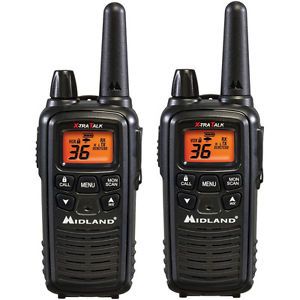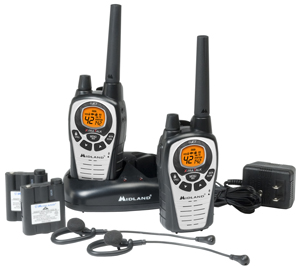Midland LXT600VP3 Review
-
Design - 9.3/10
9.3/10
-
Features - 9.1/10
9.1/10
-
Range and Sound Clarity - 9.5/10
9.5/10
-
Price - 8.2/10
8.2/10
Introduction
The Midland LXT600VP3 works right out of the box. This radio is ready and legal to use (after 12 hours to full charge) without a license on FRS only channels 8-14 and has 121 privacy codes (38 CTCSS, 83 DCS). All channels other than 8-14 out of the 36 require a GMRS license, which you need to purchase from the FCC.
Check lowest price:
build quality
The build quality is solid. The radio is extremely lightweight. A decent, yet grippy belt clip is provided with the radio. It has a non-adjustable orange back-lit screen. It also features Push To Talk. However, PTT does not activate back light. The radio features good ergonomics, and has a rubberized PTT and headset cover. The PTT button does not extrude from housing much thus lowering the risk of bumping the PTT button.
Battery
The Midland LXT600VP3 comes with a rechargeable battery and base. It also accepts 3 AAA batteries. We have had the radio on for around 8 hours, and it was on PTT FRS (low power only).We had medium radio traffic and they lasted throughout the test. We can’t give an accurate rechargeable battery life usage, but backup AAAs are there, so you need not be worried about that.
Mic and Speaker
At optimal conditions this little radio can be crystal clear. The squelch works on this radio, and we had no issues with that. The VOX (just talk, no push button) feature is nice and adjustable. We didn’t need it for our use cases, but it sure is handy when desired.
Privacy
The Midland LXT6000VP3 support two types of privacy channels: DCS and CTCSS. Continuous Tone Coded Squelch System (CTCSS) is a means by which a receiving radio will remain silent until it receives a transmission that includes a special audio Tone. As long as this Tone is Continuously received, you will be able to hear the person who is transmitting. The 38 common Tone Codes are in the range from 67 to 250 Hertz, which are in the range of normal human hearing, but most radios filter out any frequencies below 300 Hertz from reaching the speaker.
Digital Coded Squelch (DCS) is somewhat similar, but instead of sending a continuous tone of differing frequency, a Digital data transmission is added to the radio signal. This Digital Code is transmitted at a really low rate, around 134 bits per second (the code is 23 bits long). If you could hear it in the speaker, it would sound like a pulsing low bass note. There are as many as 176 DCS codes available, although some of them are not recommended for use.
This concerned us because the setup we have used before was compatible with most of our other friends’ radios, and we were not sure whether they were DCS or CTCSS type. One can obviously not ask everyone to upgrade their radios, so we knew it was a bit of a leap-of-faith buying these. Fortunately, they worked just fine; the radios my friends and I were using seem to use the DCS privacy system (and I suspect most single-system radios do as well).
Headset option
We have purchased the Midland APVH-3 headset, and it worked fine without any issues. The cord length is decent, it has solid PPT and a great VOX speaker box. You can charge it from the MIC port. The speaker/mic pin set differ from other main brands, so make sure that they are compatible when you purchase them.
As long you are using the same band and same type of radio you should be able to communicate with others regardless of the quantity or the brand of the radios. If you use the Privacy Code feature that some radios have then all the users in your group must have the same code set on their radios to be able to communicate with each other.
Range
Radio frequencies work best on line of sight, so as long as there is nothing blocking such as buildings or high hills, 30 miles is quite possible if you have the elevation and no interference from buildings or other obstructions. The radios meet maximum standards for FRS. In our tests, we found the range to vary between.5 miles – 2 miles, conditions dependent, of course. After enough research to get a doctorate on walkie talkies, these radios just work. FRS is limited to .5 watt (1/2 watt or 500 milliwatt) by the FCC, potentially the MAX range is approximately 2 miles, conditions dependent. The thumb rule is that more stuff in between the radios equals less range. GMRS has further ranges operating at 5 watts but they require a license (good for 5 years and immediate family members). On channel 11 (no sub-channel this time), we got 1.2 miles away in a mostly open area with some trees, and a hill preventing line of sight. There was an elevation difference too, of about 100 feet. From the downhill, the hill went up 100 feet over a distance of a 1/2 mile. We travelled level for a distance of almost 3/4 of a mile beyond that. At that distance, the communication had a lot of static, but it was still very usable.
The Midland LXT6000VP3 are not waterproof, but they can easily be operated when they are in a zip-lock, so you could make them water-resistant. There are 36 channels on these radios and 10 NOAA WX (weather) channels which comes in handy while traveling. There are different frequencies for these radios, and channels 8 -14 are lower power channels per FCC regulation. I’m not sure what you mean by the extra 14 channels. Channels 1 thru 22 are the only channels that allow for a privacy code setting.
Conclusions
Nothing about the radios are dissatisfying or disappointing, unfortunately they are 3x the price of the clones, but worry free. Working with .5 watt is limiting but they just simply work and do what I needed. I may upgrade to using GMRS one day and is nice to have that option. I wanted something LEGAL and just works. The main brand headset also unfortunately are pricier than generic brands and other radio brands. I like them, they work.
These are fantastic radios for the size and price. Crystal clear within the mile of forest I’ve used them in, and plenty of features and channels. One of the reasons I chose these over others is the shorter antenna (while maintaining a good distance rating) and the flat bottom – yes, finding radios that stand up is actually a feature in my book!






